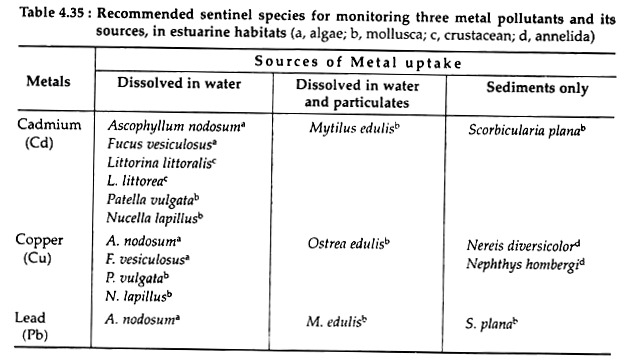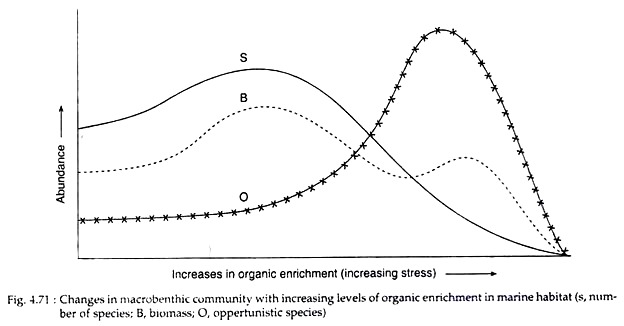In this article we will discuss about:- 1. Meaning of Biological Monitoring 2. Characteristics of Species used in Biological Monitoring 3. Approaches to Environmental Monitoring.
Meaning of Biological Monitoring:
The hazards from the industrial emissions and agriculture have led to the need of regular and frequent measurements of various toxic parameters. Simple physical and chemical determinations can be used to estimate the rates of pollutant input, distribution and dispersal in the environment and their assimilation into living tissues.
The total concentration measured in an individual may overestimate its biological significance. High levels of surface contamination or the binding of the pollutant at inert sites may mean that the effective dose is much lower. Biological monitoring is thus done to assess the significance of a pollutant for an organism in its habitat and for other members of its community.
Bio-monitoring can be defined as the measurement of changes in the biological factors of a habitat based on evaluation of the number and/or distribution of organisms or species. It focuses on biological effects at various levels of organisation-molecule, cell, organ, organism, population or ecosystem.
Characteristics of Species used in Biological Monitoring:
ADVERTISEMENTS:
The following characteristics of species are preferred in biological monitoring:
(a) Abundance:
The species should be abundant so as to allow large samples to be repeatedly taken away without significant changes in the population characteristics.
(b) Widely distributed:
ADVERTISEMENTS:
A single species of the above (as mentioned in ‘a’) can then be used to monitor large areas and to compare regions.
(c) Long-lived:
The preferred species should be long lived so as to integrate the population over more than one year.
ADVERTISEMENTS:
(d) Size:
The organism should be sufficiently large in size so as to provide sufficient tissue for analysis.
(e) Easy recognition and availability:
The species should be easy to identify and to collect at all ages, throughout the year.
Approaches to Environmental Monitoring:
There are two basic approaches to environmental monitoring-the use of monitor species and indicator species.
The difference in approaches between the two is listed:
Monitor species:
1. These species have the ability to accumulate pollutant.
2. Is used to assess the scale and distribution of a pollution insult.
ADVERTISEMENTS:
3. Generally insensitive or tolerant of the stress.
Indicator species:
1. Have the ability to accumulate pollutant.
2. Their presence or absence indicates a significant level of contamination.
3. Generally susceptible to the pollutant.
A pollutant may have several routes of entry into the body of the organism. It may become concentrated in different parts of the community. Moreover, as its input may extend throughout the community it may change the competitive or symbiotic relationships between species in or ecosystem.
In such circumstances a monitor species is selected to represent the major impacts upon a community, either by virtue of its ecology or because of its essential role in the community. Monitor species are used to map the distribution and scale of a pollution insult. It is an aid to establish emission regulations. When the organism is used to integrate the pollution signal, it is appropriately referred to as a sentinel species.
The choice of sentinel species is determined depending on their reliability as accumulators of a pollutant, exhibiting a well-defined relationship between tissue concentrations and ambient levels. Thus, the sensitivity of the detection method for a particular pollutant can be increased through the right choice of sentinel species. For example, lichens have been used to map atmospheric fluoride distribution. Sometimes more than a single sentinel species may be required to fully map a pollutant.
The desirable features of sentinel species and monitor species according to the aim of the sampling programme are given in Table 4.34.
Sentinel Species:
1. Sedentary. It measures pollutants at one point only.
2. Achieves rapid equilibrium with environmental levels.
3.Simple correlation between tissue and environmental levels.
4. Methods of accumulation should measure main source of pollutant into ecosystem.
Monitor Species:
1. Sedentary.
2. Body concentrations reflect pollutant availability to that part of the community.
3. Easy to culture in laboratory to establish nature of toxic effect.
4. An established body of knowledge on the biology of the species.
5. Sensitive indicators of likely impact on the rest of the commodity.
Sentinel species:
Sentinel species are those that achieve a rapid equilibrium between the concentrations of pollutant in its tissue and that of its habitat. The concentration levels in its tissues are always a simple reflection of ambient concentration.
Thus, the rate of uptake will be uniform over a range of environmental conditions. However, contrary to this, organisms that are able to regulate its pollution burden will produce results that are not easily interpretable.
For example, Mytilus edulis, a common bivalve mollusc, is not favoured as a sentinel species for either copper or zinc, as it has the capacity to regulate both these metals. However, their regulatory capacity ceases at higher concentrations.
It has been found that no one species (plant or animal) is suitable as a universal sentinel species for all toxic metals. Table 4.35 shows different estuarine species being recommended by Bryan (1985) as sentinel species, according to the metal and its source.
The important feature of sentinel species is its ability to achieve a rapid state between tissue and environmental concentrations. This is important when organisms are to be transplanted from uncontaminated areas to measure concentration elsewhere. A species that takes a long time to adjust to new toxic environments will give misleading values.
Monitor species:
To detect biologically significant pollution effects, monitor species are generally used. Monitor species establishes the proportion of a pollutant available for assimilation. Ascophyllum modusum (algal seaweed), has been used extensively for monitoring soluble metals because it is less prone to particulate contamination of its surface.
Ascophyllum being a producer, measures the concentrations of metals at one route of entry into a food chain (as it is the diet of herbivores). Thus, their concentration factor could be derived and their accumulation factor calculated. However, other possible routes of uptake also have to be taken into consideration.
The different uptake rates between species and their exposure to different sources suggests that a number of species are required to monitor the whole community. For example, cadmium uptake by Mytilus edulis is accelerated by the metal forming a complex with organic acids (humic acid), a major significance for filter feeders. On the other hand copper uptake by Crassostrea virginica (oyster) is reduced by binding with a number of organic complexing agents.
Toxic metals may sometimes act as analogues for an essential metal, shadowing its uptake and loss. Thus, metal pollutant’s movement into the tissue may follow routes of essential metal metabolism. For example, cadmium binds with zinc-binding proteins.
In case of Mytilus, zinc and cadmium uptake are both affected by variations in the salinity at different sites. However, the ratio of the bound metals, remain virtually unchanged. Thus, polluted sites can be identified irrespective of their salinity, where the ratio of cadmium to zinc is significantly elevated.
By reviewing several species it is possible to gain a complete picture of the impact of a pollutant on a community. Phillips and Rainbow (1988), while working in Victoria Harbour, Hong Kong, have compared the relative availability of several metal pollutants to four species of barnacles (crustacean) and one species of mussel.
All are filter feeders, yet there were major differences, particularly in cadmium uptake, between the two species. Thus, a single monitor species would give a wrong impression of the impact of cadmium on the whole biota regime.
Irrespective of the above, a single species monitoring programmes has been widely used, particularly in the case of Mytilus edulis. This species has been the subject of a global monitoring effort for toxic metals and hydrocarbons. The advantages of this species are that large amount of information are available on its response to various pollutants.
Indicator species:
The indicator species are those organisms who in their presence or absence and in all features of their phenotype and physiology, serve as an index of their environmental status. They actually indicate the general toxicity of the environment, without telling the exact physical or chemical factors responsible for this toxicity. Using the presence or absence of sensitive species to indicate habitat changes has been an age-old practice.
During the nineteenth century, lichens were suggested to be indicators of Parisian air quality. At the turn of the century, impact of sewage discharges on water bodies was measured by using indicator species that responded to nutrient enrichment and depletion of dissolved oxygen. Generally a number of indicator species (mainly invertebrates) are used to assess the scale of any stress and most of these indices are universally applicable.
The principle behind the use of such indices of indicator species is that any pollution or nutrient load results in a stress in the ecosystem. This causes changes in the number or relative abundance of many species in a community, which the index measures. Some species will be lost as they are low in number, while others will disappear due to sensitivity to the pollutant. The loss of species will create space and resources for other species.
Most communities have a number of opportunist species who will rapidly invade and dominate where disturbance is frequent. A good example is the marine poly-chaeta Capitella capitata, who shares several characteristics with other opportunistic species.
Fig. 4.71 shows changes in the marine macro benthic community with increasing levels of organic enrichment. The number of species along with the total biomass rises initially. As the larger less tolerant species disappear, biomass then declines.
The abundance of the opportunistic species (small organisms with short generation times and a high reproductive capacity) will rise as they exploit the available resources and thus, allowing a second peak in biomass. Finally, these species also succumb to very high levels of pollution.
Larger species are less abundant and more readily lost from stressed habitats and are thus unsuitable as indicator species. It is thus argued that moderately abundant species are perhaps the most appropriate indicator species.

